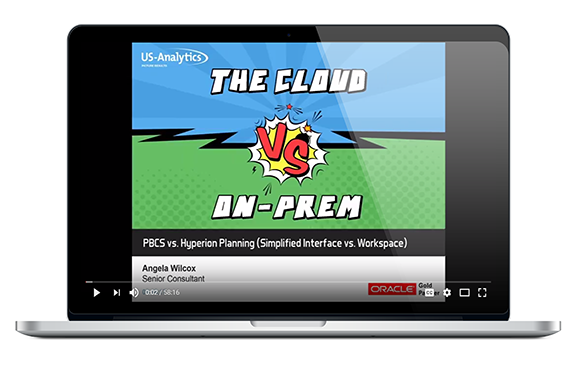The March updates for Oracle's Planning & Budgeting Cloud Service (PBCS) and Enterprise Planning and Budgeting Cloud Service (EPBCS) have arrived! This blog post outlines several new features for both applications.
The monthly update for PBCS and EPBCS will occur on Friday, April 20 during your normal daily maintenance window.
Updates for PBCS and EPBCS
Additional Charts in Activity Report
The Activity Report has been enhanced to include the following charts that help you understand the processing load in your environment:
- Number of user interface requests by hour
- Duration of user interface requests by hour
- CPU usage
- Memory usage
Migration and Audit Cards Moved to the Tools Cluster
Starting with the 18.04 update, the Migration card and Audit card will be moved to the Tools cluster in the Home page.
The Migration card enables Service Administrators to access and manage lifecycle management-related activities such as exporting and importing artifacts and data, working with snapshots, and viewing the Modified Since and Migration Status reports.
The Audit card allows Service Administrators to activate audit trails to track changes to artifacts and data. Previously, these cards were included in the Application Cluster.
Support for Subtitles in Infolets
Service Administrators can now add subtitles to infolets after the infolet header. The infolet header remains the same for all views of an infolet, but you can now add an optional subtitle which can be customized to display different text for each view of an infolet. To add subtitles to an infolet, open an infolet in the Infolets Designer and hover over the upper right corner of the infolet to view the Infolet Menu. Under Layout, select Subtitle.
Schedule Jobs to Run Hourly and by Minute
You can now schedule jobs to run in 15 minute, 30 minute, and hourly increments. Jobs scheduled to run hourly, for example, will start to run in exactly one hour. So if you set the job to run hourly and the time is currently 3:11, the job will start to run at 4:11, then 5:11, and so on.
You can set the frequency of By Minute jobs for 15 or 30 minutes. The job will start running in 15 or 30 minutes and continue to run at the selected frequency until the ending date and time; for example, if you set the job to run every 15 minutes and the current time is 3:15, the job will start to run at 3:30, then 3:45, and so on.
Jobs cannot be scheduled to run in increments smaller than 15 minutes.
New Financial Reporting Explore Repository
For new subscriptions, Financial Reporting has implemented a new Explore repository, which is very similar to the existing Explore repository.
Existing subscriptions will be migrated to the new Explore repository in a near term release. The Explore repository documentation has been updated.
New Design Time Prompt in Calculation Manager
The new Calculation Manager design-time prompt, @PlanDimMember, returns a member if it is valid for the specified dimension in the specified plan type.
New Row And Column Suppression Behavior
Service administrators can use the Smart View Suppression Behavior option to change suppression behavior when both the Smart View No Data/Missing and Zero suppression options for rows, or columns, or both are selected.
If the Smart View Suppression Behavior option in the web application is set to:
Legacy: Only suppresses rows or columns containing either all No Data/Missing or all Zeros. Does not suppress rows or columns containing a combination of No Data/Missing and Zeros. For example, in Smart View, if both the No Data/Missing and Zero suppression options are selected for rows, and a row contains both zeroes and Missing labels, then the row is displayed; it is not suppressed.
Standard: Suppresses rows or columns containing all No Data/Missing or all Zeros, or a combination of both. For example, in Smart View, if both the No Data/Missing and Zero suppression options are selected for columns, and a column contains both zeroes and Missing labels, then the column is suppressed; it is not displayed.
Updates for EPBCS Only
Simplified Merit-Based Planning
In the Workforce business process, you can now set default percentage rates for merit increases and apply them to other entities. The merit increase for the year is included in the base salary calculations of that year and carried forward into the base salary for subsequent years. Planning merit rates by entities enables you to calculate salaries that include merit increases when performance ratings aren’t available. This capability also lets you plan merit rates at a more generic level than basing the merit rates on performance ratings.
To plan merit rates at the entity level, select Compensation Planning, then the the Assumptions tab, and then the Merit Rates form. Select the entity, and then enter the merit rate percentage into the new Default Merit member.
A new business rule—Copy Merit Rates— enables you to copy merit rates from one entity to other level 0 entities based on the members selected in the rule prompt. Access the rule from the Action menu on the Merit Rates form, and in the rule prompt, select the parent or child entity member whose merit rate you want to copy and the target level 0 member to copy the rate to. Selecting a source parent member enables you to easily push merit rates.
Apply to Button in Forecast Method
In the Strategic Modeling Smart View extension, the Forecast Method now includes an Apply To button for free form formulas. Apply To enables you to apply the free form formula to selected sub-accounts and children.
Removal of Support
Financial Reporting Studio Desktop Client
Financial Reporting Web Studio, available since March 2016, will become the only environment for designing and building reports.
Oracle is providing additional time for users to transition from Financial Reporting Desktop Studio to Financial Reporting Web Studio. Tentative plans call for functional parity between Financial Reporting Web Studio and Financial Reporting Desktop Studio in 2018, at which time, support for the Desktop Studio will transition to the Web Studio and distribution of the Desktop Studio will cease. This transition is currently planned for the 18.06 update (June 01, 2018 for test and June 15, 2018 for production environments).
Oracle recommends that you transition to using Financial Reporting Web Studio at the earliest opportunity. Please send questions and concerns to Oracle using the Provide Feedback option in the service.
Classic Dimension Editor
With the February 2018 (18.02) update, the Dimensions link in the Navigator will link to the Simplified Dimension Editor. Effective February 2018 (February 2, 2018 for test and February 16, 2018 for production environments), the Simplified Dimension Editor will be the only interface available to edit and manage dimensions.
Composite Form Creation Capability
The ability to create composite forms (forms that comprise multiple simple forms) will not be available to new subscriptions effective18.06 (June 2018 update).
New subscriptions should use the dashboard functionality instead of composite forms. This change does not affect existing subscriptions/customers. There will be no further enhancements to the composite forms functionality.







